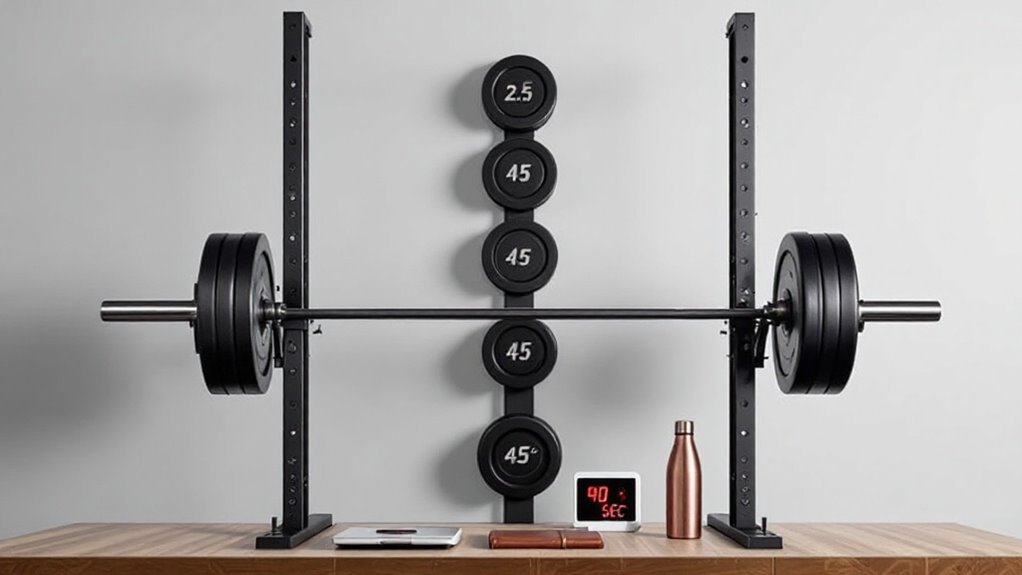Weight Training Schedule for Women

A successful weight training schedule for women focuses on 3-4 weekly sessions incorporating compound exercises like squats, deadlifts, and bench presses. Each workout targets specific muscle groups through progressive overload while allowing adequate rest between sessions. Proper form and consistent tracking guarantee steady strength gains and muscle development. Following a structured approach with proven exercises augments results while preventing injury. The journey to strength begins with mastering these fundamental principles.
Key Takeaways
- Start with a 3-day split routine focusing on push exercises, pull exercises, and lower body workouts with rest days between.
- Include compound movements like squats, deadlifts, and bench press to maximize strength gains and overall muscle development.
- Begin with 2-3 sets of 8-12 repetitions per exercise, gradually increasing weight and intensity through progressive overload.
- Schedule 48 hours between training the same muscle groups to ensure proper recovery and prevent overtraining.
- Track workouts using a structured planner to monitor progress and maintain consistency while focusing on proper form.
Setting Up Your Weekly Training Split

A well-designed weekly training split serves as the foundation for any successful weight training program.
A strategically planned weekly workout schedule lays the groundwork for achieving your fitness goals through proper strength training progression.
For women beginning their strength journey, a 3-4 day split allows adequate recovery while maintaining consistency. The most effective approach divides workouts by major muscle groups, preventing overtraining and maximizing results.
A basic three-day split might include: pushing movements (chest, shoulders, triceps) on day one, pulling exercises (back, biceps) on day two, and lower body training on day three.
Rest days between sessions promote proper recovery and reduce injury risk. This structured approach creates a sustainable training rhythm for long-term progress.
Using a customizable planner template helps track your exercises and maintain accountability throughout your weekly training schedule.
Essential Compound Exercises for Maximum Results

Compound exercises form the cornerstone of any effective weight training program, delivering maximum results through multi-joint movements that involve multiple muscle groups simultaneously. These foundational exercises optimize workout efficiency and hormonal response, leading to improved strength gains and fat loss. Following proper progressive overload principles is crucial for consistent muscle development and strength gains.
| Exercise | Primary Muscles | Benefits |
|---|---|---|
| Squats | Quads, Glutes, Core | Total lower body strength |
| Deadlifts | Back, Hamstrings, Core | Full posterior chain development |
| Bench Press | Chest, Shoulders, Triceps | Upper body pushing power |
| Pull-ups | Back, Biceps, Core | Vertical pulling strength |
| Overhead Press | Shoulders, Triceps, Core | Shoulder stability and strength |
When performed with proper form and progressive overload, these exercises create the foundation for a powerful, functional physique.
Progressive Overload and Rest Periods

Proper execution of compound exercises lays the groundwork for strength development, but understanding progressive overload and rest periods determines the ultimate success of any weight training program.
Progressive overload involves gradually increasing weight, frequency, or repetitions to continually challenge the muscles, while strategic rest periods allow for peak recovery and growth.
Success in strength training comes from the delicate dance of pushing harder while giving your body time to adapt and rebuild.
- Track each workout meticulously, celebrating small victories as weights increase and form improves
- Listen to your body's signals – rest is not weakness, but a vital component of becoming stronger
- Challenge yourself with incremental increases every 1-2 weeks to maintain steady progress
- Master the balance between pushing limits and allowing adequate recovery time for muscle repair
Both mechanical tension and metabolic stress play crucial roles in stimulating muscle growth and strength adaptations.
Common Mistakes and Form Corrections

Learning to identify and correct form mistakes represents the essential difference between developing strength safely and risking injury during weight training. Common errors include rounding the back during deadlifts, failing to involve core muscles, and using momentum instead of controlled movements.
Women often rush through repetitions, compromising proper alignment and muscle involvement. Key corrections include maintaining neutral spine position, keeping shoulders back and down, and focusing on mind-muscle connection throughout each exercise.
Video recording workouts helps identify form issues. Working with qualified trainers initially guarantees proper technique development, creating a foundation for long-term strength gains without setbacks. Following a structured progressive overload approach ensures steady strength improvements while maintaining proper form.
Frequently Asked Questions
Should I Train During My Menstrual Cycle?
Training during menstruation is not only safe but can be beneficial. Research shows that strength training during menstruation helps reduce cramps, bloating, and mood swings.
Hormonal fluctuations don't greatly impact performance or muscle gains. However, energy levels may vary, so adjusting workout intensity based on how one feels is recommended.
The key is listening to the body while maintaining consistency in training.
What Should I Eat Before and After Weight Training?
Pre-workout nutrition should include complex carbs like oatmeal or whole grain toast paired with protein such as eggs or Greek yogurt, consumed 1-2 hours before training.
Post-workout, focus on fast-digesting protein (whey shake or lean meat) and simple carbs (fruits or rice) within 30 minutes to enhance recovery and muscle growth.
Stay hydrated throughout with water and electrolytes.
Can Weight Training Make Women Too Muscular or Bulky?
Just like hoping to become a chess grandmaster by playing casually, women won't accidentally become overly muscular from weight training.
Women's hormonal makeup, specifically lower testosterone levels, makes it extremely difficult to develop bulky muscles. Weight training typically results in a lean, toned physique.
Even female bodybuilders must follow intense training protocols, strict diets, and sometimes supplementation to achieve significant muscle mass.
How Do Hormonal Changes Affect Strength Gains in Women?
Hormonal fluctuations during menstrual cycles markedly impact women's strength training progress.
During the follicular phase, raised estrogen levels improve strength and recovery.
The luteal phase may reduce strength performance due to progesterone dominance.
Testosterone levels, though lower than in men, still play an essential role in muscle development.
Understanding these hormonal patterns allows for strategic training adjustments to maximize strength gains throughout the month.
What's the Best Workout Clothing and Footwear for Weight Training?
Proper workout attire includes moisture-wicking compression wear or fitted clothing that allows full range of motion while preventing fabric snags.
A supportive sports bra is essential.
Footwear should feature flat, stable soles – specialized weightlifting shoes or cross-trainers are ideal.
Avoid running shoes with cushioned heels, as they compromise stability.
Belt-loops, zippers, and loose clothing can interfere with proper form and safety.
Final Thoughts
Research shows that women who participate in regular weight training see a 20-30% increase in strength within the first 8 weeks of consistent training. By following a structured weight training program focused on compound movements, proper progression, and adequate rest, women can effectively build lean muscle, increase bone density, and boost metabolism. The key lies in maintaining proper form, staying consistent, and gradually increasing intensity for ideal results.


